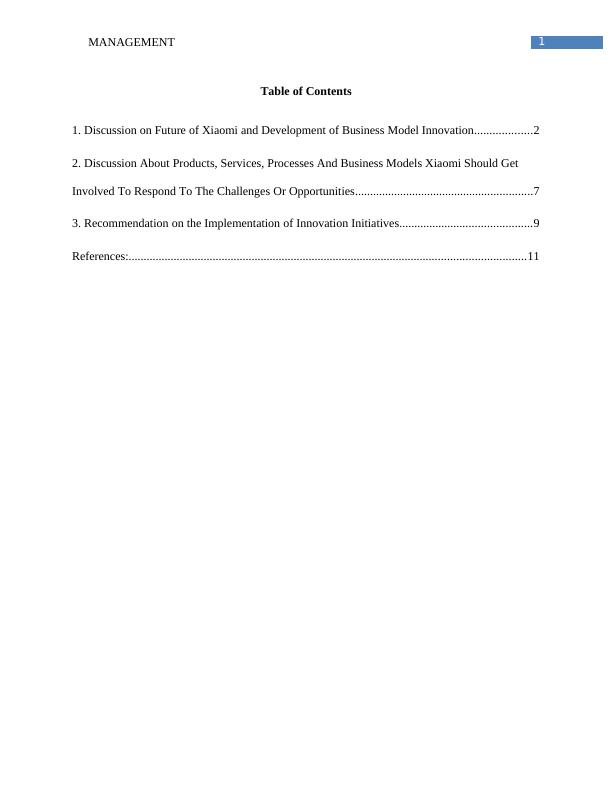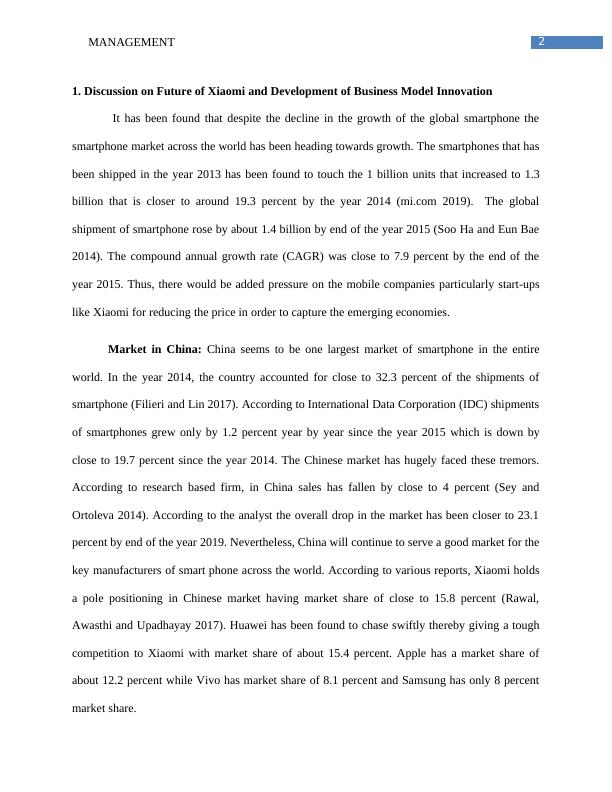Corporate Entrepreneurship and Business Model Innovation
Added on 2022-08-29
13 Pages2941 Words12 Views
Running head: MANAGEMENT
Corporate Entrepreneurship and Business Model Innovation
Name of the Student:
Name of the University:
Author Note:
Corporate Entrepreneurship and Business Model Innovation
Name of the Student:
Name of the University:
Author Note:

1MANAGEMENT
Table of Contents
1. Discussion on Future of Xiaomi and Development of Business Model Innovation...................2
2. Discussion About Products, Services, Processes And Business Models Xiaomi Should Get
Involved To Respond To The Challenges Or Opportunities...........................................................7
3. Recommendation on the Implementation of Innovation Initiatives............................................9
References:....................................................................................................................................11
Table of Contents
1. Discussion on Future of Xiaomi and Development of Business Model Innovation...................2
2. Discussion About Products, Services, Processes And Business Models Xiaomi Should Get
Involved To Respond To The Challenges Or Opportunities...........................................................7
3. Recommendation on the Implementation of Innovation Initiatives............................................9
References:....................................................................................................................................11

2MANAGEMENT
1. Discussion on Future of Xiaomi and Development of Business Model Innovation
It has been found that despite the decline in the growth of the global smartphone the
smartphone market across the world has been heading towards growth. The smartphones that has
been shipped in the year 2013 has been found to touch the 1 billion units that increased to 1.3
billion that is closer to around 19.3 percent by the year 2014 (mi.com 2019). The global
shipment of smartphone rose by about 1.4 billion by end of the year 2015 (Soo Ha and Eun Bae
2014). The compound annual growth rate (CAGR) was close to 7.9 percent by the end of the
year 2015. Thus, there would be added pressure on the mobile companies particularly start-ups
like Xiaomi for reducing the price in order to capture the emerging economies.
Market in China: China seems to be one largest market of smartphone in the entire
world. In the year 2014, the country accounted for close to 32.3 percent of the shipments of
smartphone (Filieri and Lin 2017). According to International Data Corporation (IDC) shipments
of smartphones grew only by 1.2 percent year by year since the year 2015 which is down by
close to 19.7 percent since the year 2014. The Chinese market has hugely faced these tremors.
According to research based firm, in China sales has fallen by close to 4 percent (Sey and
Ortoleva 2014). According to the analyst the overall drop in the market has been closer to 23.1
percent by end of the year 2019. Nevertheless, China will continue to serve a good market for the
key manufacturers of smart phone across the world. According to various reports, Xiaomi holds
a pole positioning in Chinese market having market share of close to 15.8 percent (Rawal,
Awasthi and Upadhayay 2017). Huawei has been found to chase swiftly thereby giving a tough
competition to Xiaomi with market share of about 15.4 percent. Apple has a market share of
about 12.2 percent while Vivo has market share of 8.1 percent and Samsung has only 8 percent
market share.
1. Discussion on Future of Xiaomi and Development of Business Model Innovation
It has been found that despite the decline in the growth of the global smartphone the
smartphone market across the world has been heading towards growth. The smartphones that has
been shipped in the year 2013 has been found to touch the 1 billion units that increased to 1.3
billion that is closer to around 19.3 percent by the year 2014 (mi.com 2019). The global
shipment of smartphone rose by about 1.4 billion by end of the year 2015 (Soo Ha and Eun Bae
2014). The compound annual growth rate (CAGR) was close to 7.9 percent by the end of the
year 2015. Thus, there would be added pressure on the mobile companies particularly start-ups
like Xiaomi for reducing the price in order to capture the emerging economies.
Market in China: China seems to be one largest market of smartphone in the entire
world. In the year 2014, the country accounted for close to 32.3 percent of the shipments of
smartphone (Filieri and Lin 2017). According to International Data Corporation (IDC) shipments
of smartphones grew only by 1.2 percent year by year since the year 2015 which is down by
close to 19.7 percent since the year 2014. The Chinese market has hugely faced these tremors.
According to research based firm, in China sales has fallen by close to 4 percent (Sey and
Ortoleva 2014). According to the analyst the overall drop in the market has been closer to 23.1
percent by end of the year 2019. Nevertheless, China will continue to serve a good market for the
key manufacturers of smart phone across the world. According to various reports, Xiaomi holds
a pole positioning in Chinese market having market share of close to 15.8 percent (Rawal,
Awasthi and Upadhayay 2017). Huawei has been found to chase swiftly thereby giving a tough
competition to Xiaomi with market share of about 15.4 percent. Apple has a market share of
about 12.2 percent while Vivo has market share of 8.1 percent and Samsung has only 8 percent
market share.

3MANAGEMENT
Future of the Corporation: Xiaomi has been a smartphone manufacturer that aims at
overtaking Huawei and Apple to become the second biggest phone after Samsung. The company
considers itself to be an internet company providing smartphones and smart hardware connected
by the IoT platform at the core (Bieliński 2016). It sells higher end phones and devices at lower
prices maintaining thin margins. This helps it in creating a marketplace for the connected
products, lifestyle, entertainment and the digital service. Xiaomi also tagged as the “Apple of
China” follows a reverse approach to Apple that sell high end phones at higher margin and price.
Xiaomi on the other hand makes use of third party apps for driving the demand for the
manufacturing business of the phone. However, similar to Apple, Xiaomi is able to oversee a
future in the services and internet of things (IoT) depending on a platform oriented growth
strategy thereby orchestrating an innovative ecosystem. There are various facets of Xiaomi that
seems impressive. One of them being how the company nurtured its fans that provided it with
rapid idea and feedback through interactive forums. The users have been found to spend
minimum of 4.5 hours on their devices that creates the opportunities for monetization (Böhmer,
and Krüger 2013). This acts as the crucial part of ecosystem strategy that proved successful in
sustaining the growth even after there was significant decline of the sales between the 2014 and
2016 (Gupta and Dhillon 2014). With a sales of close to over 60million and valuation of $45
million by the end of 2014, the company did not fail in creating an impression. The predictions
regarding the ability of Xiaomi in translating success in the worldwide emerging markets lay it
ignoring certain potential problems. Thus, the future of Xiaomi would be wrapped in the
following challenges:
1. Cost of Licensing Patents and Fighting Lawsuits: The rise of Xiaomi is attributed
to its strategy of emulating Apple. In spite of the fact that Xiaomi held a different attitude
Future of the Corporation: Xiaomi has been a smartphone manufacturer that aims at
overtaking Huawei and Apple to become the second biggest phone after Samsung. The company
considers itself to be an internet company providing smartphones and smart hardware connected
by the IoT platform at the core (Bieliński 2016). It sells higher end phones and devices at lower
prices maintaining thin margins. This helps it in creating a marketplace for the connected
products, lifestyle, entertainment and the digital service. Xiaomi also tagged as the “Apple of
China” follows a reverse approach to Apple that sell high end phones at higher margin and price.
Xiaomi on the other hand makes use of third party apps for driving the demand for the
manufacturing business of the phone. However, similar to Apple, Xiaomi is able to oversee a
future in the services and internet of things (IoT) depending on a platform oriented growth
strategy thereby orchestrating an innovative ecosystem. There are various facets of Xiaomi that
seems impressive. One of them being how the company nurtured its fans that provided it with
rapid idea and feedback through interactive forums. The users have been found to spend
minimum of 4.5 hours on their devices that creates the opportunities for monetization (Böhmer,
and Krüger 2013). This acts as the crucial part of ecosystem strategy that proved successful in
sustaining the growth even after there was significant decline of the sales between the 2014 and
2016 (Gupta and Dhillon 2014). With a sales of close to over 60million and valuation of $45
million by the end of 2014, the company did not fail in creating an impression. The predictions
regarding the ability of Xiaomi in translating success in the worldwide emerging markets lay it
ignoring certain potential problems. Thus, the future of Xiaomi would be wrapped in the
following challenges:
1. Cost of Licensing Patents and Fighting Lawsuits: The rise of Xiaomi is attributed
to its strategy of emulating Apple. In spite of the fact that Xiaomi held a different attitude

End of preview
Want to access all the pages? Upload your documents or become a member.
Related Documents
Business Research Methodologylg...
|10
|1634
|41
International Business Strategy (IBM) Contents Purpose 3 Scope 3 Limitation 3 Countries Shortlisted Countries 5 Poland Market Overviewlg...
|27
|5650
|247
Global Marketing strategy and planninglg...
|12
|2755
|1
Data Analysis of Samsung, Nokia, Apple and Motorola in the Global Smartphone Marketlg...
|8
|1857
|212
Electronic Commerce Strategies in the Smartphone Industrylg...
|7
|1418
|204
Impact of US-China Trade War on Xiaomi's Businesslg...
|8
|2393
|98
